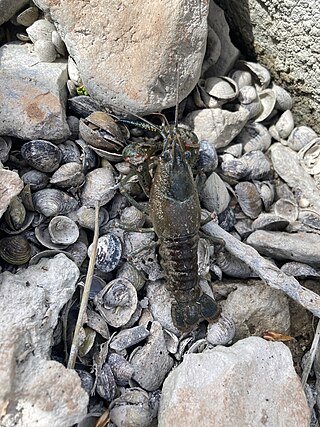
Shelta Cave is a 2,500-foot-long (760 m) cave and lake located in Huntsville, Madison County, Alabama, United States. It is described as one of the most bio-diverse caves within the Appalachian Mountains. The cave is currently owned and managed as a nature preserve by the National Speleological Society, with their main offices directly above the cave. It was declared a National Natural Landmark in October 1972.
Faxonius cooperi, the Flint River crayfish, is a species of crayfish in the family Cambaridae. It is endemic to Alabama and Tennessee in the United States. The common name refers to the Flint River, where the original specimens were found.

Faxonius deanae, the Conchas crayfish is a species of crayfish in the family Cambaridae. It is endemic to the United States. The common name refers to the Conchas Lake, where the original specimens were found.

Faxonius hartfieldi, the Yazoo crayfish, is a species of crayfish in the family Cambaridae. It is endemic to Mississippi in the United States.
Faxonius holti, the bimaculate crayfish, is a species of crayfish in the family Cambaridae. It is endemic to Alabama where it occurs in a limited portion of the lower Tombigbee and central Alabama drainages.
Orconectes incomptus is a species of crayfish in the family Cambaridae. It is endemic to Tennessee. It is also known as the Tennessee cave crayfish.
Faxonius jonesi, the Sucarnoochee River crayfish, is a species of crayfish in the family Cambaridae. The common name refers to the Sucarnoochee River, near where the original specimens were found in Kemper County, Mississippi. It is endemic to Mississippi and Alabama in the United States.
Faxonius saxatilis is a species of crayfish in the family Cambaridae. It is endemic to tributaries of the Kiamichi River, Le Flore County, Oklahoma. Its common name is Kiamichi crayfish.
Procambarus milleri, the Miami cave crayfish is a species of crayfish in the family Cambaridae. It is endemic to Florida, where it is known from 14 to 15 sites in Miami-Dade County, Florida, and is listed as an endangered species on the IUCN Red List.

Orconectes australis, the southern cave crayfish, is a species of crayfish in the Cambaridae family found in Alabama and Tennessee. Ages of 176 years have been claimed for O. australis, though this was reduced to ≤22 years in a 2012 study.
Faxonius alabamensis, the Alabama crayfish, is a species of freshwater crayfish that lives in Alabama, Mississippi and Tennessee.
Faxonius difficilis, the painted crayfish, is a species of crayfish in the family Cambaridae. It is endemic to Oklahoma and Alabama in the United States.
Orconectes packardi, the Appalachian cave crayfish, is a species of crayfish in the family Cambaridae. It is endemic to Kentucky, where it is found in 16 caves in four southeastern counties in the Cumberland River basin.
Cambarus speleocoopi, the Sweet Home Alabama cave crayfish, is a small, freshwater crayfish endemic to Marshall County, Alabama in the United States. It is an underground species known only from 4 caves.

Orconectes pellucidus, the Mammoth Cave crayfish, is a freshwater crayfish native to karst landscapes in Kentucky and Tennessee in the United States.
Orconectes barri, the Cumberland Plateau cave crayfish, is a species of crayfish in the family Cambaridae. It is native to Kentucky and Tennessee in the United States, where it is found in nine caves on the Cumberland Plateau.
Orconectes inermis, the Northern cave crayfish, is a troglomorphic freshwater crayfish native to Kentucky and Indiana in the United States.
Faxonius stygocaneyi, the Caney Mountain cave crayfish, is a small, freshwater crayfish endemic to Missouri in the United States. It is a cave-dwelling species known from only one cave, Mud Cave in Ozark County, Missouri. This cave is Protected as part of the Caney Mountain Conservation Area, which covers 7,899 acres (3,197 ha) of public land administered by the Missouri Department of Conservation.
Orconectes inermis testii, known as the unarmed crayfish, is one of two subspecies of the northern cave crayfish, along with Orconectes inermis inermis.








